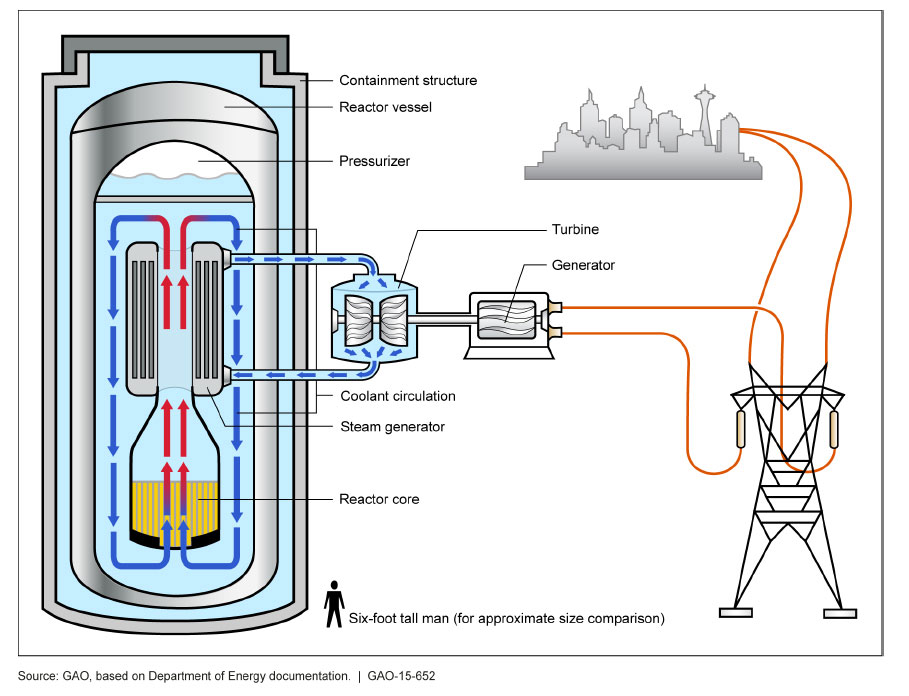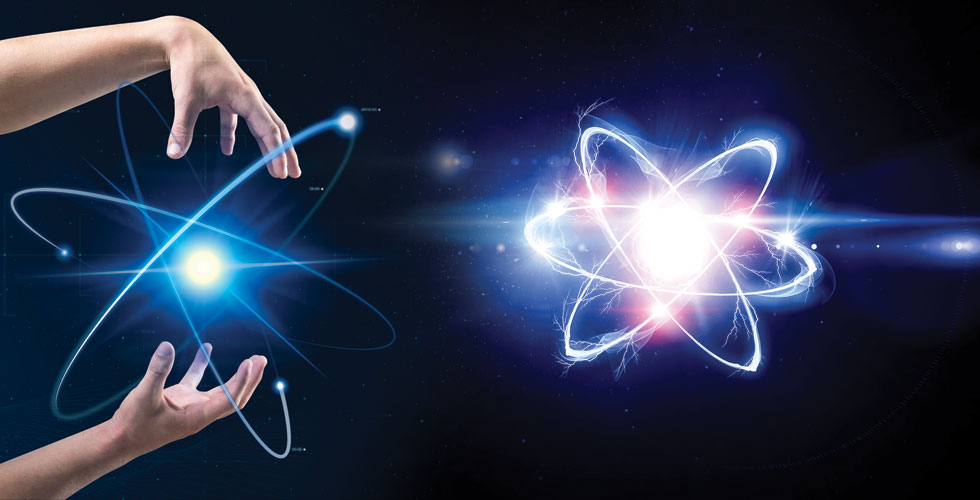SMR
Contents
ToggleSMR what is it?
SMR stands for Small Modular Reactor, which can be translated as 'small modular reactor'. An SMR is a type of nuclear reactor that is smaller in power and size compared to traditional nuclear reactors used in nuclear power plants.
A distinctive feature of SMRs is their scalability. Such a reactor is built from smaller modules that can be manufactured in factories and then transported to the site. In this way, the modular design of the SMR enables the flexible and rapid construction of a reactor with different capacities, depending on the needs of the site or the energy infrastructure.
SMR aims to provide electricity safely, increasing the use of nuclear power and reducing greenhouse gas emissions. Potential applications for SMRs include electricity generation, industrial heat generation, seawater desalinisation or use in submarine propulsion systems.
Many manufacturers, both public and private, are working on the development of SMR technology. There are many different SMR designs and constructions, differing in the type of nuclear fuel, cooling technology and method of controlling the nuclear reaction.

What fuel is needed for an SMR reactor?
SMR reactors can be designed to use different types of nuclear fuel. Here are some examples of common fuel types used in SMR reactors:
- Uranium fuel: Many SMRs use uranium fuel such as enriched uranium-235 or MOX (Mixed Oxide) fuel containing both uranium-235 and plutonium-239. Uranium is a commonly used nuclear fuel in many reactors due to its availability and efficiency.
- Thorium fuel: Some SMR projects rely on the use of thorium fuel, such as thorium-232. Thorium is a natural element that can be converted to nuclear fuel by transmutation processes. Thorium fuel has several advantages, including higher efficiency and lower risk of nuclear weapons proliferation.
- Combustible fuel: Other SMR projects are exploring the use of combustible fuels, such as combustible salts, which consist of a mixture of fluoride salts with dissolved nuclear fuel. Combustible fuel may have some advantages, such as greater resistance to melting and higher thermodynamic efficiency.
It is worth noting that different SMR reactor designs may use different fuel types depending on specific requirements and technology. The choice of fuel depends on a number of factors, such as efficiency, safety, raw material availability and technological requirements.
Minimum SMR dimensions?
The minimum dimensions of SMR reactors can vary depending on the specific design and technology. However, in general, SMRs are designed to be significantly smaller than traditional nuclear reactors used in nuclear power plants.
Indicatively, the minimum dimensions of an SMR may include:
- Power: Reactors are typically designed to generate electricity at tens to hundreds of electric megawatts (MWe). There are also SMR designs with even lower capacities, at the level of a few megawatts.
- Physical size: SMR reactors tend to have a smaller physical size than traditional nuclear reactors. They can have a diameter in the order of a few to several metres and a length in the order of several tens of metres. These sizes allow the reactor modules to be transported by land, sea or air.
- Modularity: the reactors are built in a modular fashion, meaning that they are made up of smaller components that can be prefabricated in the factory and then assembled on site. These modules can vary in size, but are designed to be easy to transport and install.
It is worth noting, however, that the dimensions of the reactor depend on the specific design and technologies that are used. Different companies and research institutions are developing different SMR concepts, which can vary in both power and size.
Is the use of SMRs in households envisaged?
Currently, SMRs are not envisaged as a direct source of energy for households. Reactors are mainly designed for larger applications such as industrial-scale power generation, supplying energy to the electricity grid, heat generation for industry or water desalinisation.
The main reasons why SMR is not envisaged for households include:
- Scalability: the reactor is designed to be an elaborate device that requires support infrastructure such as cooling systems, safety, nuclear waste management, etc. It would not be economically efficient or practical to scale the SMR down to a low power output that would be suitable for a single household.
- Safety and regulation: Nuclear reactors, including SMRs, are subject to strict safety regulations and are subject to oversight by the relevant regulatory authorities. Introducing a nuclear reactor into a household would require significant changes in regulation and the provision of appropriate safety measures, which would be difficult to achieve on such a small scale.
- Alternative energy sources: There are now many alternative energy sources available to households, such as solar, wind, geothermal, as well as traditional power grids. These alternatives are often more economical and tailored to the needs of individual households than nuclear reactors.
Technology may emerge in the future to harness the energy from SMRs on a smaller scale, but at present the main purpose of these reactors is to provide energy to larger areas and industrial infrastructure.
Reactors in motor vehicles a fiction or a not-too-distant future?
SMRs (Small Modular Reactor) in automotive vehicles can currently be considered more of a fiction than a near future. There are many technological, safety, economic and logistical challenges that need to be solved before the possible introduction of nuclear reactors in automotive vehicles.
Here are some reasons why SMR in motor vehicles is currently more fictional than real:
- Scalability and size: Nuclear reactors, including SMRs, are of considerable size and require special infrastructure such as cooling systems, safety systems, and access to nuclear fuel. It is currently impractical and uneconomical to scale them to a size that would be suitable for automotive vehicles.
- Safety: safety is a key consideration, especially for nuclear reactors that are on the move. The safe storage and handling of radioactive material is complex and requires stringent protection measures that would be extremely difficult to apply to moving vehicles.
- Economics: Introducing reactors into motor vehicles would incur huge costs in designing, building and maintaining the infrastructure needed to operate nuclear reactors. These costs are currently disproportionate to the economic benefits that could result from such an application.
There are now other technologies, such as electric cars with lithium-ion batteries, which are more viable options in the context of low- or zero-emission vehicles. Nevertheless, various alternative energy sources for vehicles are being explored and scientists and engineers continue to research new technologies, including the use of nuclear power in transport. However, for the foreseeable future, SMR in motor vehicles remains rather a fiction.
Is it possible to miniaturise reactors, analogous to the miniaturisation of computers?
Miniaturisation is theoretically possible, as has been the case with computers. However, it should be noted that miniaturisation of nuclear reactors poses many technological, safety and regulatory challenges.
Here are some factors to consider in the context of miniaturisation:
- Safety: safety is a key consideration for nuclear reactors, both larger and smaller. A miniaturised reactor would need to incorporate appropriate safety measures and preventive systems to ensure safe operation, especially in the event of an accident.
- Cooling: Nuclear reactors require effective cooling to maintain adequate operating temperatures and prevent melting of the nuclear fuel. Miniaturisation would mean the need for effective cooling systems that are efficient enough for a smaller reactor.
- Fuel and fuel cycle: Miniaturisation may also require the use of other types of nuclear fuel that are more suitable for a smaller reactor. In addition, the fuel cycle, including the production, reprocessing and reprocessing of nuclear fuel, would need to be scaled and adapted to a smaller reactor accordingly.
- Regulation: The introduction of miniaturised nuclear reactors would require changes to current nuclear regulation. Regulatory organisations would have to adapt their standards and procedures to take into account the safety and risks associated with smaller reactors.
Although miniaturisation is theoretically possible, most research and development is currently focused on medium and larger SMRs, which have the potential to provide electricity on a larger scale. Miniaturisation and commercialisation of smaller reactors remains a major technological challenge and would require further research and technological development.






